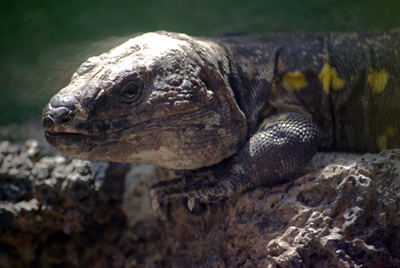
As the trade winds hit the island, they're forced upwards, and the water vapour, picked up from the sea, forms clouds. This means that El Hierro often has a cloud pouring over the top, much like
the cloud waterfall on La Palma. Unlike La Palma, there aren't nearly as many trees to trap the fog in their leaves so that it drips onto the ground, which makes El Hierro much drier.
This makes any tree that does so, very important. At the time of the Spanish invasion, the Garoé was a large tree (a or
Ocotea foetens or Til) which grew near the summit of the ridge at the north of the island. It was so important that the
Bimbaches (the pre-hispanic inhabitants) considered it sacred, and the water it provided helped them to resist the invasion for a while. Legend says that the secret of the tree's location was betrayed by a local girl who fell in love with a Spanish soldier. Once the Spanish controlled the drinking water supply, the Bimbaches had to surrender, but the girl was condemned to death.
Sadly, the original tree was destroyed by a storm in 1610. Rather surprisingly, a replacement wasn't planted until 1957.
Today it's a beautiful place. You can drive along the track with care, or you can walk about 3 km from the tarmaced road. I saw it in the mist, whch was wonderfully atmospheric, but I'm told when it's sunny, it's lovely in a completely different way.
The last little bit of the path is downhill. You pass a tiny souvenir shop, tucked away around the corner so that you can't see it from the tree. Then you find a series of natural (or perhaps just very, very old pools) near the tree, which is tucked in a hollow in the hill. (I took this photo from the back of the hollow.) I suspect that the original tree was big enough to have its crown well above the sides, so that it would have collected much more water. Nonetheless, it's a special place, and I'm very glad to have seen it.





